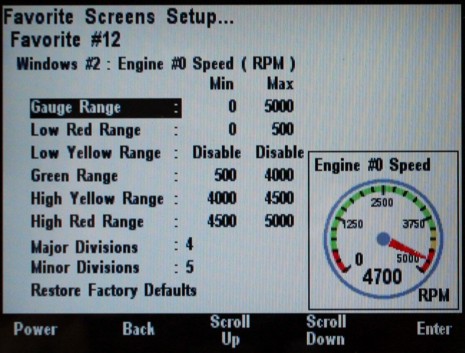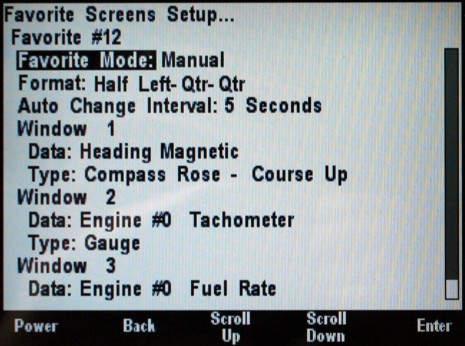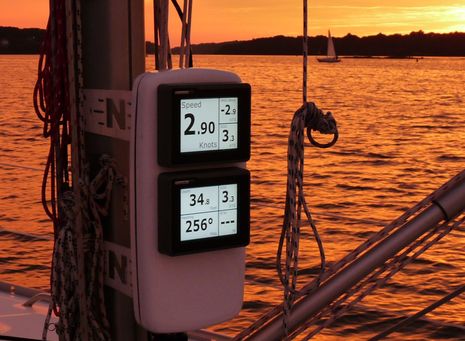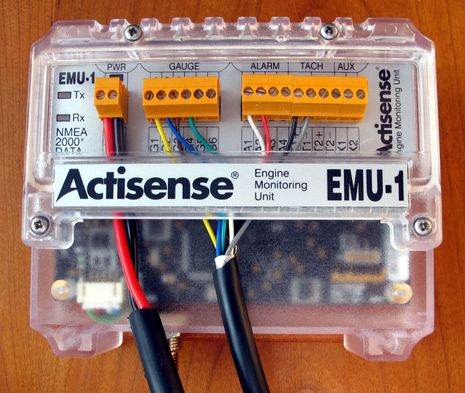Maretron DSM250, nice screen config details

I was pleased to find this fine set of gauge configuration options on the Maretron DSM250. Note how you can set the RPM dial’s range, tick marks, and warning colors. Nice! Note too the live demo of the gauge you’re building (there are RPMs and other engine PGNs on the Panbo network now, thanks to a Lowrance simulator). Display customization is one reason why virtual gauges can be superior to real ones, but so far few of the N2K instruments I’m testing take much advantage of the possibilities. You can’t even set the range on either the GMI 10 or ST70 speed dials, which means you’ll constantly be reminded of how fast you can’t go. And, good as the DSM250 is, it doesn’t even have a speed gauge yet, or a depth graph.
Below is the setup screen prior to the one above, and it shows some more good Maretron work. The DSM250 has twelve “Favorite Screens”, which is four more than the ST70 and eight more than the GMI 10 ‘custom’ screen family (though Garmin’s concept of multiple screen families has great potential if made more flexible). The DSM also has the most powerful screen mode abilities. There are four choices under that highlighted choice below. Manual means this screen will only show when I’m in Manual and flipping through screens myself. It could also be seen only in Auto mode—with it’s own custom interval period—or in both Manual and Auto modes. Or I can shut it off altogether, but not lose the screen. By contrast, the ST70 has an auto or rolling screen mode, but it’s all or none with a single setable time interval, and Garmin doesn’t roll at all. At any rate I hope all these developers are checking out each other’s work intently, because I want to see an instrument with configuration details like this, the iconic—and fun—operating system of the ST70, and the very sleek graphics seen on some GMI 10 screens!














Very nice. But to keep it in context, this display is 2x the cost of the Furuno, even the b/w DSM200 is 40% more expensive. The Maretron also consumes 13x more power and is physically larger. I think it’s an interesting data point of what is possible with a bit mapped display and an investment in s/w, but with it’s greater cost, higher power consumption and larger physical size, it’s not exactly an apples to apples comparison with even the Raymarine or Garmin displays, and certainly not with the Furuno or Simrad.
However, this does give me an opportunity to pitch one of my favorite ideas for displays.
The Maretron display is very configurable, but the menu structure and size of the display is still a limitation. There are a lot of screens to crawl through to set up the entire instrument. I suggest there is a better way.
Create a configuration program that runs on a PC and do 90% of the configuration there with a much larger screen and more more powerful UI that does not have to be invented from scratch by the mfg. Connect the computer to the network and download the configuration to the display. Most of us have a computer permanently mounted in the boat, why struggle with small screens and large menu heirarchies? It’s easier for the mfg and for the user to do the configuration on a PC.
There are probably some tweeks that we’d like to do on the fly directly on the instrument, but the kind of configuring that Ben is showing is not going to be done on a daily basis.
Thanks, Russ, excellent comment! I think your config concept is doable, and should be done.
Right on Russ! (You saved me a lot of typing tonight.)
I would also add to your comments about having the GUI creation tool on a PC, that there should be no reason why
1) PC users can’t save any choice of specific guages, whole page/screen, and whole configurations into a tidy file they can email to other users for import. So for example, Ben could share the specific dial configuration above with people that own his exact type of boat and may find configuration difficult … no matter how easy it appears to us.
2) A level of mapping added so any parameter from any PGN can go to any visual display element, even for PGN’s that have yet been invented. (maybe if PGN’s were converted to XML for the sake of the PC program, it would be easy to use existing software libraries to do this mapping)
3) Ideally in the future a PGN will exist to transport user created data thru a gateway onto N2K (or an ethernet port exist on the display), so user created data can be co-displayed. A direct application of this would be my desire to create a PC software application that takes true wind speed and true wind angle as inputs, and outputs target boat speed for my current sail configuration.
Dan
I may be missing something, but doesn’t Maretron’s NK2View just about cover your display idea, Russ?
I’ve looked at their demo and from an engine instrument standpoint there isn’t much you can’t easily configure.
The only thing that holds me up from using it to replace a couple sets of “steam” gauges is the cost.
Jon
Jon,
Yes, N2KView does have gauge building software like the DSM250, but it’s a high end PC solution for large yachts. Russ’s concept is simple, inexpensive N2K gauges that don’t need a complex configuration UI because that’s done on a PC connected to N2K network.
Hi…
Commented on this (and a few other topics) the other night, but it disappeared. The on-topic bit was that I love Russ’ configuration idea, but would be even more delighted with a web-based version that emails or FTP-hosts a file that could then be handed off to the unit (assuming a suitable interface, of course… maybe even “packetized” through the USB100). This approach could change quickly to allow a library of user-contributed screens or reflect new offerings from other vendors.
This could be wishful thinking, but it would be platform-agnostic and even more flexible (assuming an available net connection for a few minutes, of course!).
Thanks for the heads-up on DSM-250 power, Russ – about to get two of something, and am now going to hang back a bit until the NN3D and new autopilot are in.
Cheers,
Steve
Thanks, Steve, and sorry about accidentally junking your first comment. I found it though, and love the Panbo stroke:
********************
I like the external configuration idea, but, as one who avoids Windows (except alas, for the embedded version in the new Furuno MFDs), I would prefer to see it web-based. This would allow the vendor to continuously tweak the tools to reflect new competitors’ devices, ongoing innovation, and even user-submitted screens… without having to provide a succession of download versions. The resultant configuration file could be injected into the target device via any normal network protocol.
I know, I’m dreaming. This would require an N2K gateway widget, but heck, I’m buying the USB100 anyway just to provide a PGN stream into my on-board Mac-based web server that uses Ruby on Rails to collect and display a whole range of ship data collection channels, and it would seem to be “simply a matter of programming” once that hook is in place.
Today I put a deposit on my Furuno MFD12 (with an MFD8 to follow), Simrad AP24 and pumpset, Maretron SSC200, and other goodies… thanks, Ben, for the steady flow of observations and comments that have helped considerably with decision support. Panbo is more useful than a boat show, by far.
Anyway, on the DSM250, I didn’t realize the power was so thirsty – thanks for pointing that out, Russ! I noticed the heat, but would certainly not have guessed 13x. Also, it is lacking in alarm options (beyond XTE and +/- depth) and the fonts are oddly rough for such a nice little screen… though it certainly is an alluring device both functionally and aesthetically. Since I need 2 or 3 N2K displays, I’ll make this decision a bit more slowly and hope for the best-of-all-worlds solution posited in the original post.
By the way, speaking of power, we did some quick measurements on the Furuno MFD12 today. Running on 12-13 VDC, the steady-state operating current was 2.6 amps, but it dropped to a very reasonable 1.1 when the screen was fully dimmed. There will be a rule when meandering between pilothouse and outside helms…… turn it down!
Cheers,
Steve
Hi from S/V Nomadness, where I have spent the day defining the N2K network (Maretron backbone and sensors, USB100 for the server, 2 NavNet 3D MFDs, and a Simrad AP24 autopilot). My wallet hurts.
I have a few notes and comments, since Googlage just landed me back at this posting.
The power issue makes the DMS250 kind of a non-starter for me… the eye candy is admittedly very nice, but unless I’m mistaken, the monochrome DSM200 will do everything identically at 200 mA instead of 650 mA. I am hoping that the previous comments here on screen config suggest ongoing developments in this arena.
Ben, have you thought of adding a forum to Panbo.com to allow discussion threads on these endlessly interesting topics with more useful tools than linear blog commentary? There are some great forums out there already, of course, but you’ve carved out a niche that makes for a good prefilter.
Oh, I have heard on good authority that the Maretron GPS100 doesn’t like to be near a radar scanner; I had hoped to park it in the same box as the compass sensor on my radar arch to simplify cabling. Any other random gotchas from those with more experience than I, before it’s too late?
Thanks and cheers from the floating lab,
Steve
Hi Steve,
I haven’t talked or researched much about the N2K power stuff, but I should. Did you ask Maretron if those are maximum or typical power draws? Might that make a difference for you? The 250 is much brighter, hence more often dimmable, and its faster. And I’ll bet you like fast.
Yes, I’d really like to add forums. The hold up, besides my being a hamster-in-a-cage deadline guy, is that it seems like Movable Type might offer a reasonable and well integrated solution.
Maretron does provide computer generated screen setup using the Maretron N2K Analyzer.